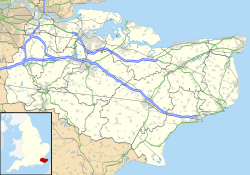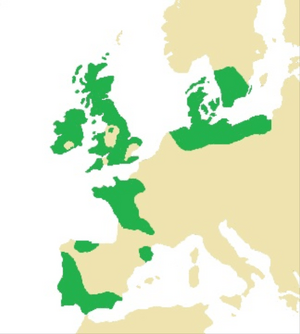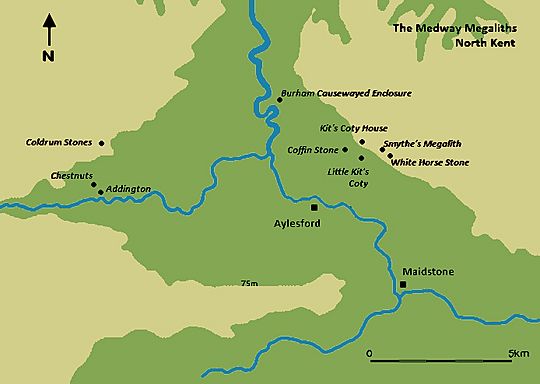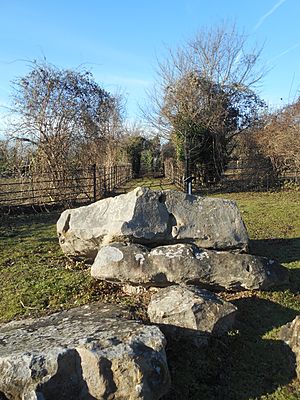Little Kit's Coty House facts for kids
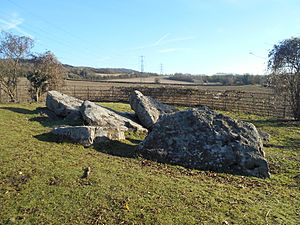
The stones of Little Kit's Coty House as they now appear
|
|
| Alternative name | Lower Kit's Coty House |
|---|---|
| Coordinates | 51°18′57″N 0°30′05″E / 51.3159675°N 0.5013867°E |
| Type | Long barrow |
| History | |
| Periods | Early Neolithic |
Little Kit's Coty House, also called Lower Kit's Coty House or the Countless Stones, is an ancient stone monument. It is a type of tomb called a chambered long barrow. You can find it near Aylesford in Kent, England. People built it around 4000 BCE, during the early Stone Age in Britain. Today, it is in ruins.
Experts who study ancient sites, called archaeologists, believe that early farming communities built this monument. This was soon after people started farming in Britain, learning from people in Europe. Little Kit's Coty House is part of a group of similar tombs called Medway Megaliths. These are found near the River Medway. Other nearby sites include Kit's Coty House and the Coffin Stone.
Today, the site looks like a pile of large sarsen stones. It was likely a tomb, similar to the Coldrum Stones. The name "Countless Stones" comes from a belief that the stones are impossible to count. There are many old stories about what happens to those who try. Depending on who you ask, there are between 19 and 21 stones. In the 1600s, people pushed them over.
Contents
What is Little Kit's Coty House?
Little Kit's Coty House is also known as Lower Kits Coty and the Countless Stones. The site is surrounded by iron railings but is always open for visitors. It is about 450 meters south of another Medway Megalith called Kit's Coty House. The site is about 3 kilometers northeast of Aylesford and has signs from the Rochester Road.
Life in the Early Stone Age
The Early Neolithic period was a time of big changes in Britain. Between 4500 and 3800 BCE, people started farming instead of hunting and gathering. This new way of life came from continental Europe. Kent was an important place for people to arrive from Europe because of the River Thames and its closeness to the continent.
Britain was mostly covered in forests back then. Large forests were not cleared in Kent until much later, around 1000 to 700 BCE. Evidence from nearby areas shows that the land was still heavily forested in the Early Neolithic. Most people in Britain at this time did not live in permanent homes. Archaeologists think they were mostly herding cattle and moving around.
The Medway Megaliths: Ancient Stone Tombs
In Western Europe, the Early Neolithic was the first time humans built huge structures in the landscape. These included chambered long barrows. These were long, rectangular mounds of earth with a chamber built inside one end. Some chambers were made of wood, but others used very large stones, called "megaliths."
These long barrows were often used as tombs. People were usually buried together in these tombs, not alone. This tradition of building stone tombs spread from Europe to Britain around 4000 BCE. Even though some stone buildings existed before them, these chambered long barrows were the first widespread use of stone in construction by humans.
The Medway Megaliths are now in ruins, but when they were built, they were some of the biggest and most impressive tombs in Britain. They are located along the River Medway, cutting through the North Downs. They are the only group of megalithic monuments in eastern England. Archaeologists like Brian Philp and Mike Dutto call them "some of the most interesting and well known" sites in Kent.
The Medway Megaliths are in two main groups. One group is west of the River Medway, and the other is on Blue Bell Hill to the east. The distance between them is about 8 to 10 kilometers. The western group includes Coldrum Long Barrow, Addington Long Barrow, and the Chestnuts Long Barrow. The eastern group has Smythe's Megalith, Kit's Coty House, and Little Kit's Coty House. Other stones, like the Coffin Stone, might also have been part of these structures. We don't know if they were all built at the same time or if they had different purposes.
All the Medway long barrows followed a similar plan. They were all lined up from east to west. Each had a stone chamber at the eastern end of the mound. They probably also had a stone front at the entrance. Their chambers were very tall, up to 3 meters high, which is taller than most other similar tombs in Britain.
The chambers were built from sarsen stone. This is a very hard and strong stone found naturally in Kent. Early Neolithic builders would have chosen large blocks from the local area and moved them to the building site. These shared features show that the people who built them had a strong connection in this region.
Archaeologists believe the people who built these monuments were influenced by tombs they already knew. We don't know if these builders grew up in the Medway area or moved there from somewhere else. Experts have suggested different places in Europe as the origin of these designs. However, it is "impossible to indicate" an exact place with the evidence we have.
How Little Kit's Coty House Was Built
In 2005, experts counted about 21 stones at the site. Many of these stones were once part of a chamber at the eastern end of a long, rectangular earth mound. Some stones were likely from the chamber itself, and others from the front part of the tomb.
The sarsen stones at Little Kit's Coty House are among the largest found in the Medway Megaliths. Based on their size, one archaeologist, Paul Ashbee, thought the chamber would have been about 5 meters long, 2.4 meters wide, and 2.7 meters high. He believed that the stones fell to the north from their original spots. If the site were fully dug up, the holes where the stones once stood might be found. This could help rebuild the chamber, like at Chestnuts Long Barrow.
Another archaeologist, Timothy Champion, suggested that the long barrow would have been at least 20 meters wide and possibly over 90 meters long. The mound might have had a ditch around it, which is now filled in.
Damage to the Ancient Site
All the surviving stone tombs from the Early Neolithic period have been damaged over time. Little Kit's Coty House has been harmed more than once. In 1773, people heard that a farmer tried to break up the monument to use its stones for roads. However, the stones were too big for this purpose.
Stories and Modern Beliefs
In 1722, an expert named Hercules Ayleway wrote about a local belief. People thought that Lower Kit's Coty House and Kit's Coty House were built to remember two kings of Kent who died in battle.
The idea that the stones are "countless" probably started after the tomb fell apart, around 1690. Even in the mid-1900s, this story was still told. People found numbers written in chalk on the stones, showing they were still trying to count them.
Some modern Pagan religions, like Druidry, use the Medway Megaliths for their practices. In 2014, research showed that some Druids had rituals at Little Kit's Coty House. However, at least one Druid did not like performing rituals there because of the noise from nearby power cables.
Studying Little Kit's Coty House
An early expert, John Aubrey, wrote about ancient sites in Britain between 1663 and 1693. He included a letter from Dr. Thomas Gale, who said: "In the field next to this [Kit's Coty House] nearer to Ailsford, are 13 or 14 great stones; seven standing, all covered with one large stone, the rest are fallen down. The people call this also Kit's Coty-house." The site might have been damaged more after this letter.
Another expert, William Stukeley, visited the area in 1722. By then, the stones had already fallen. A letter to him suggested the tomb was taken apart about 30 years earlier. Stukeley made several drawings of the site, which were published after he died. His drawings show Little Kit's Coty House and Kit's Coty House. However, his pictures are not always accurate.
In 1782, Edward Hasted published details about the site, including an engraving. He thought the site was damaged by people looking for treasure. Later, others suggested the monument was destroyed so its stones could be used for paving. In 1824, Edward Rudge published a note and drawing of the site. He said that digging under one stone found human bone and armor.
In the 1840s, the site started to be called the "Countless Stones." The Reverend Beale Post studied the Medway Megaliths. He disagreed with earlier ideas about how the monument was destroyed. He thought that a burial space might have collapsed, and then weather caused the chamber to fall. In 1871, Edwin Dunkin published a plan of the site, which was different from Rudge's, perhaps because the site had changed.
In 1883, the archaeologist Augustus Pitt Rivers visited the site. He talked to the landowner, who believed both Little Kit's Coty House and Kit's Coty House should be protected. In 1897, Little Kit's Coty House became a protected monument. In 1893, George Payne described it as a "fallen cromlech" (another name for a stone tomb). He noted other large stones nearby, suggesting they were part of this monument or another one.
In 1994, a pipe trench was dug next to the site. During this work, evidence of a ditch was found below the soil.


